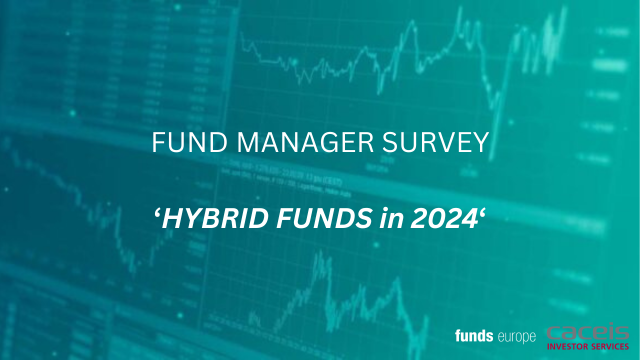In a recent webinar, Funds Europe talked to Chris Iggo, Fixed Income CIO at AXA Investment Managers, about yield opportunities in the bond market and the benefits of short-duration strategies.
Bond funds have proved popular with investors in recent years and the attraction has certainly continued in 2017. Corporate bonds in both developed and emerging markets (EM) have received positive inflows so far this year as investors take more risk in search of yield. Within the emerging market space, hard currency bonds have proved more popular than local currency bonds by a ratio of two to one.
But, says Chris Iggo, Fixed Income CIO at AXA IM, it is important to look beyond today’s low volatility landscape and consider longer-term factors in the pursuit of a sustainable yield. In particular, investors should look at the best ways to further diversify their fixed income portfolios and should consider looking to emerging market bonds through a short duration approach.
What do today’s macro conditions mean for yields?
Macroeconomic factors are the key determinants of interest rates and credit spreads and are therefore critical to any fixed income forecast, says Iggo. He identifies three broad themes – the global economic cycle, central bank policy and geopolitical trends – all of which suggest an increase in bond yields.
Growth in the US is broadening out to Europe and emerging markets, and is showing no obvious signs of slowing. Furthermore, China is in a stronger position than 18 months ago with government policy stabilising the economy. Central bank policy has also been largely positive with the Federal Reserve raising interest rates and looking to reduce the size of its balance sheet, the European Central Bank (ECB) considering an end to its quantitative easing, and even the Bank of England looking at raising interest rates due to the rising risk of inflation.
Lastly, there has been a tilt towards political populism as a result of years of austerity and widening inequality, underlined by some unexpected election results. In economic terms, this political shift should lead to a more aggressive use of fiscal policy and less accommodative monetary policy. When put in the context of an expanding global economy, all of these macro developments should lead to higher bond yields in the long term.
However, there are downsides to consider, warns Iggo. On the monetary policy side, the ECB’s eventual decision to wind down its bond purchases could negatively impact Italy due to the country’s ongoing bank resolution challenges. Meanwhile geopolitical risks are always on the horizon, with the most recent concern emanating from North Korea and its possible nuclear capability. Inflation could also play a part, although it has softened recently as a result of falling oil prices and a stagnation in wages despite tightening labour markets.
Fixed income yields are still close to historic lows, particularly in the case of the government bonds of the major economies. Income from bond investing has therefore been very low in recent years, although a sustained period of low volatility has provided some mitigation, enabling some carry trades and coupon-clipping, but it is still a relatively fragile relationship, warns Iggo, and it would not take a big rise in volatility to wipe out those yield benefits. For example, a recent move in gilts was enough to wipe out a whole year’s worth of carry for many parts of the bond market.
In addition to macro factors and yields, investors should also consider valuations, market sentiment and some technical factors, says Iggo. “At AXA IM we regularly assess each segment of the global bonds universe using these factors to get a qualitative view of where value lies. Based on our current assessments, we still see more value in credit than in government bonds due to a considerable margin in relative performance. More specifically, we favour high yield and emerging markets when it comes to credit because they can offer an attractive credit risk premium over investment grade and developed markets respectively.”
Yield opportunities in emerging markets
Emerging market bonds are a preferred sector and a primary means of diversification, says Iggo, thanks to an improving macro cycle, recent reform boosts and the longer-term premium which EM bonds offer over their developed market peers. After a torrid time in 2015-16, the macro outlook in emerging markets has improved thanks to rising commodity prices and some successful economic reforms in countries like Argentina.
“In previous years EM bonds offered a real yield premium and this helped grow inflows,” says Iggo. “And if the macro factors remain positive, these inflows will increase. Sentiment and technical factors like leverage levels are also good. There has been $45 billion of inflows into EM bonds already this year and the issuance of debt has been well contained, creating a positive relationship between supply and demand.”
Iggo says that within emerging markets, AXA IM has tended to have high exposure to Russia, Brazil, Turkey, Indonesia and more recently the Middle East, based on the corporate opportunities as opposed to the sovereign factors. “It is more about the individual, bottom-up opportunities. On a sovereign basis we have favoured the Latin America economies as opposed to the Asian economies because it is an expensive market in terms of credit risk despite the strong performance of the Asian fixed income market.”
One of the most successful strategies for AXA IM within emerging market bonds has been its short-duration strategy, which typically has a duration of less than three years. “By focusing on shorter durations and adopting an absolute-return rather than index-based approach, it helps us mitigate against short-term volatility, for example should sovereign risk begin to pick up.”
Short duration at AXA IM
More broadly, AXA IM has a long history of managing short-duration strategies in fixed income, having done so for more than 15 years. It currently invests more than €25 billion in short-duration funds globally and employs nine different strategies across the full fixed income risk spectrum, so considers itself a European market leader in the space. AXA IM’s range of short-duration strategies are based on an investment philosophy that seeks to capture most of its returns from income-generating short-dated bonds, while minimising volatility, and it is an approach that Iggo believes is well suited to the current trends in fixed income and the hunt for yield.
The strategies also benefit from a natural liquidity profile. As a good proportion of each strategy’s bonds naturally mature each year, this helps lower trading costs and creates the opportunity for managers to reinvest cash at higher yields as interest rates rise, and to react to changes in inflation.
Driven by an investment approach that focuses on the macro outlook and strong credit research, AXA IM’s short-duration strategies aim to offer investors lower volatility and less downside risk than the all-maturities market across key asset classes covering investment grade, high yield, inflation and emerging markets.
©2017 funds europe





